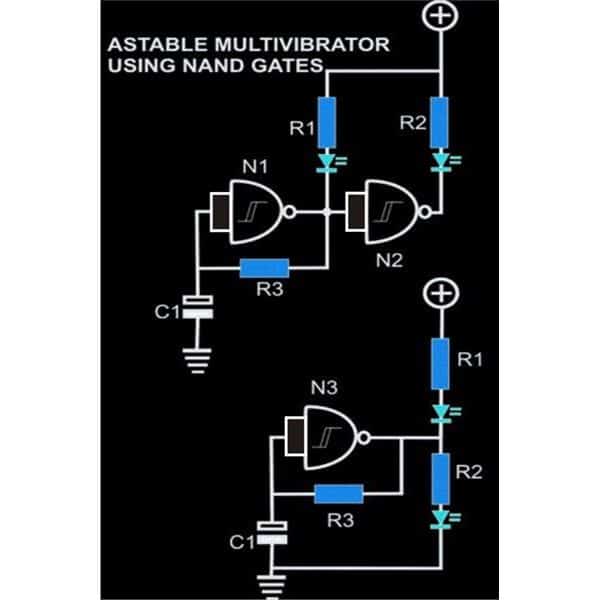An astable multivibrator is referred to an electronic configuration which is able to generate continuous alternate high and low pulses from a couple of outputs, operating in tandem.
Why IC 4093
You might have well come across such astable circuits using a couple of transistors, a couple of capacitors and a few resistors.However more simpler and effective astable multivibrator circuit can be built usng a single IC 4093.
The IC 4093 basically consists of four individual NAND gates in one package, these are schmitt trigger types, which means the gates provide some sort of hysteresis at their outputs in response to the input signals.
The circuit diagram shows how simply just a couple of gates may be configured into an effective astable mutivibrator circuit.
Using NAND Gates
In the figure, gate N1 and the associated passive parts R3 and C1 form the basic oscillator stage. The output of N1 generates alternate square wave pulses at its output having fixed mark and space ratio.
The frequency of these pulses can be varied as per the users choice by simply changing the value of either R3 or C1.
Preferably, R3 may be replaced with a 100K pot for facilitating quick alteration of the pulse rates.
The output frequency may be set by using the formula f = 1/T = 1/2.2RC, where R is R3 and C is C1 in the shown diagram.
The pulses generated at the output of N1 is fed to the input of the next NAND gate, which is wired up as an inverter by shorting its input pins. Note that basically the inputs of all the gates are short circuited, thus they all behave as inverters here.
As the name refers to, in an inverter mode the gate N2 just inverts the response from N1 at its output.
It means that, when the output from N1 is high, the output of N2 become low and vice versa.
The outputs of these gates are able to support LEDs directly at their outputs, so we connect a few of the LEDs at their outputs which dance or blink in response to the astable pulses.
The bottom figure shows how a single gate may also be wired for obtaining results exactly similar to the upper design.
Astable Multivibrator (AMV) Circuit Using NAND Gates or IC 4093
R1, R2 = 1K,
R3 = 100K pot
C1 = 10uF/25V
IC = 4093

Hi Rory, I have tried to explain it in the above comment, please refer to it.
The mark time is given by the relationship:
tH =1.1 RC
Similarly the space time is indicated by:
tL »1.1 RC
Hence the period can be expressed as:
T = tH + tL = 2.2 RC
Finally the formula for RC oscillator frequency may be given as:
f = 1/T = 1/2.2 RC
Hi Swagatam,
is there any information available on this constant of 2.2? I can accept that it is universally applicable, but I really like to know the origin or see the proof of such constants for my own understanding of the math behind the circuit function.
I am also curious. I can be on board with 2.2 being a constant shared by all manufacturers, but how was is determined?